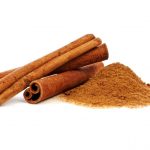A spice made from the bark of the cinnamon tree. It has a penetrating aroma and pleasant astringent flavor.
Cinnamon is referred to in the Old Testament and in even older Sanskrit texts, thus affirming that it was one of the first spices to be used in flavouring food and wine. The word cinnamon derives from the ancient Hebrew name of the spice, quinnamon. In England, however, where the cinnamon tree is not native, cinnamon was not referred to by name until the mid fifteenth century almost five hundred years after the appearance of pepper. Before it is powdered, cinnamon is sold in quills, so called because the rolled sheets of bark look like the quills, made from feathers, once used as pens.
A volatile oil derived from the bark of Cinnamomum zeylanicum. It is used as a flavoring agent in cooking and in preparing pharmaceutical products.
True cinnamon, an exquisite spice with a sweet and delicate flavor, is sourced from a tree that thrives in Ceylon and along the Malabar coast of India. Its powdered form boasts a rich golden-brown hue, and its culinary uses are plentiful – from pies, cakes, and cookies to a variety of main dishes. However, the “cinnamon” commonly used in the United States is predominantly derived from cassia bark, rather than the true cinnamon bark.
Cinnamon is the bark derived from a tropical tree that belongs to the laurel family. It is commonly utilized to impart flavor to a variety of sweet dishes, such as cakes, fruit, sweet pickles, and mulled wine. The highest quality cinnamon exhibits a pale, yellowish-buff hue and possesses a fragrant taste. This type of cinnamon is sold in stick form, as broken pieces, or ground into a fine powder. It is essential not to confuse cinnamon with cassia, as the latter is an inferior substitute with a less desirable flavor profile.
The desiccated bark from a tree employed both as a spice and as a carminative, which was once popular for its supposed efficacy in treating feverish colds.

